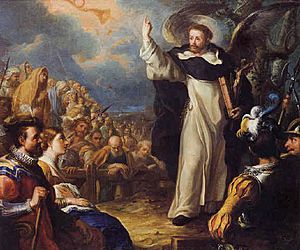Pedro Rodriguez de Miranda facts for kids
Pedro Rodríguez de Miranda (1696–1766) was a talented Spanish painter from the late Baroque period. He was known for his detailed artwork, especially paintings that showed landscapes and scenes from everyday life. His art helped capture what life was like in Spain during the 1700s.
Contents
Early Life and Training
Pedro Rodríguez de Miranda was born and died in Madrid, the capital city of Spain. He came from a family of artists. His uncle, Juan García de Miranda, was also a well-known painter. Pedro learned how to paint by studying with his uncle. This was a common way for young artists to learn their craft back then.
His First Supporters
Early in his career, Pedro had an important supporter named Father Aller. Father Aller was a confessor to Prince Philip, a member of the royal family. Having someone important like Father Aller believe in his work helped Pedro get noticed and receive commissions for his paintings.
Famous Paintings
Pedro Rodríguez de Miranda created many different types of paintings. Some of his early works were for religious buildings.
- He painted scenes from the Life of the blessed Caracciolo for a cloister. A cloister is a covered walkway, often found in a convent, which is a religious community.
- He also painted the Story of the prophet Elias for a chapel. This chapel was located in the church of the Convent of the barefoot Carmelites.
Landscapes and Everyday Life
While he did paint religious scenes, Pedro Rodríguez de Miranda is most famous for his landscapes and genre paintings.
- Landscape paintings show natural scenery, like mountains, rivers, or forests. Pedro often added people to his landscapes, making them more lively.
- Genre paintings show scenes from everyday life. These paintings might show people working, playing, or just going about their daily routines.
In Spain, these types of paintings were sometimes called bambochadas. This name came from similar paintings made by Italian artists called the Bamboccianti. These artists focused on showing ordinary people and their daily lives, which was a bit different from the grand, dramatic art often seen in the Baroque period.
A Royal Connection
Pedro's uncle, Juan García de Miranda, held an important position as the King's painter. This meant he was an official artist for the Spanish royal family. When his uncle passed away, the position became open. Pedro Rodríguez de Miranda was a strong candidate to take over this role. However, he also died soon after his uncle, so he wasn't able to fully take on the prestigious job of King's painter.
See also
 In Spanish: Pedro Rodríguez de Miranda para niños
In Spanish: Pedro Rodríguez de Miranda para niños


